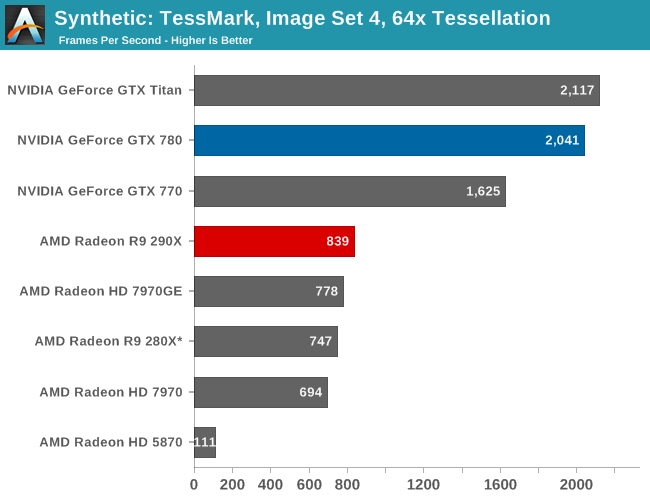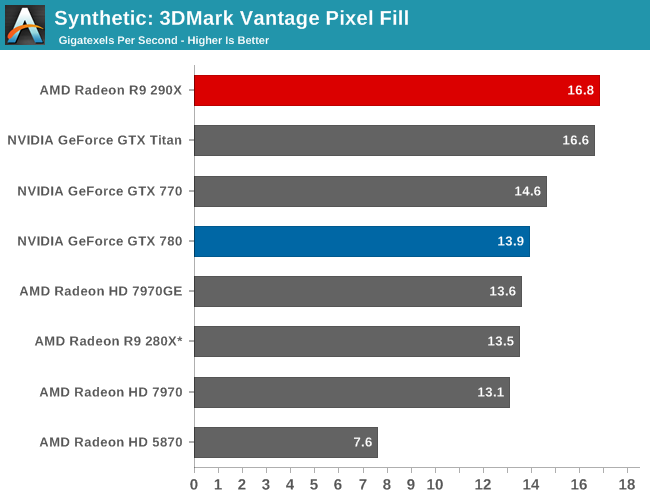The AMD Radeon R9 290X Review
by Ryan Smith on October 24, 2013 12:01 AM EST- Posted in
- GPUs
- AMD
- Radeon
- Hawaii
- Radeon 200
Synthetics
As always we’ll also take a quick look at synthetic performance. The 290X shouldn’t pack any great surprises here since it’s still GCN, and as such bound to the same general rules for efficiency, but we do have the additional geometry processors and additional ROPs to occupy our attention.

Right off the bat then, the TessMark results are something of a head scratcher. Whereas NVIDIA’s performance here has consistently scaled well with the number of SMXes, AMD’s seeing minimal scaling from those additional geometry processors on Hawaii/290X. Clearly Tessmark is striking another bottleneck on 290X beyond simple geometry throughput, though it’s not absolutely clear what that bottleneck is.
This is a tessellation-heavy benchmark as opposed to a simple massive geometry bencehmark, so we may be seeing a tessellation bottleneck rather than a geometry bottleneck, as tessellation requires its own set of heavy lifting to generate the necessary control points. The 12% performance gain is much closer to the 11% memory bandwidth gain than anything else, so it may be that the 280X and 290X are having to go off-chip to store tessellation data (we are after all using a rather extreme factor), in which case it’s a memory bandwidth bottleneck. Real world geometry performance will undoubtedly be better than this – thankfully for AMD this is the pathological tessellation case – but it does serve of a reminder of how much more tessellation performance NVIDIA is able to wring out of Kepler. Though the nearly 8x increase in tessellation performance since 5870 shows that AMD has at least gone a long way in 4 years, and considering the performance in our tessellation enabled games AMD doesn’t seem to be hurting for tessellation performance in the real world right now.
Moving on, we have our 3DMark Vantage texture and pixel fillrate tests, which present our cards with massive amounts of texturing and color blending work. These aren’t results we suggest comparing across different vendors, but they’re good for tracking improvements and changes within a single product family.

Looking first at texturing performance, we can see that texturing performance is essentially scaling 1:1 with what the theoretical numbers say it should. 36% better texturing performance over 280X is exactly in line with the increased number of texture units versus 280X, at the very least proving that 290X isn’t having any trouble feeding the increased number of texture units in this scenario.

Meanwhile for our pixel fill rates the results are a bit more in the middle, reflecting the fact that this test is a mix of ROP bottlenecking and memory bandwidth bottlenecking. Remember, AMD doubled the ROPs versus 280X, but only gave it 11% more memory bandwidth. As a result the ROPs’ ability to perform is going to depend in part on how well color compression works and what can be recycled in the L2 cache, as anything else means a trip to the VRAM and running into those lesser memory bandwidth gains. Though the 290X does get something of a secondary benefit here, which is that unlike the 280X it doesn’t have to go through a memory crossbar and any inefficiencies/overhead it may add, since the number of ROPs and memory controllers is perfectly aligned on Hawaii.










396 Comments
View All Comments
rituraj - Saturday, October 26, 2013 - link
So that "PROSUMER" cookie that nv tried to sell was just a grandma's cookie and it's proven now. I will buy the next maxwell flagship AND AT $600. (Lol.. I have to pay 20% more here in India)dazaj - Friday, October 25, 2013 - link
why is there no titan sli in all these benches but there is 290x cfRyan Smith - Friday, October 25, 2013 - link
Because we only have 1 Titan.just4U - Friday, October 25, 2013 - link
They likely didn't have two on hand..dazaj - Friday, October 25, 2013 - link
why is there no titan sli in any of these benchesdrinkperrier - Friday, October 25, 2013 - link
Just 1 question.Can i have the possibility to buy this videocard from AMD brand and not asus, sapphir and etc??
Ryan Smith - Friday, October 25, 2013 - link
Unfortunately no. AMD does not directly sell Radeon cards to consumers. They only directly sell Radeons to OEMs, while FirePros are directly sold to everyone.rituraj - Saturday, October 26, 2013 - link
The best thing I can get out of this release is that nVidia is not going to be able to charge $1000 for its next flagship or ultra-flagship. Because it's been proven that no matter what crazy performance it gives, it can be released at a 500-600 range by AMD and therefore by nVidia too. Even if they do, charge that much people will j7st wait for a few months for AMD to release an equally powerful card at 600 or 500. Good move AMD...SunLord - Saturday, October 26, 2013 - link
Saturday and I'm still not sure the reviews done or at least Anandtech has dropped making explaining and commenting on test resultspolaco - Saturday, October 26, 2013 - link
Origin PC will loose lots of possible sells by having dropped AMD. NVidia monopolistic friends pay the consequences...